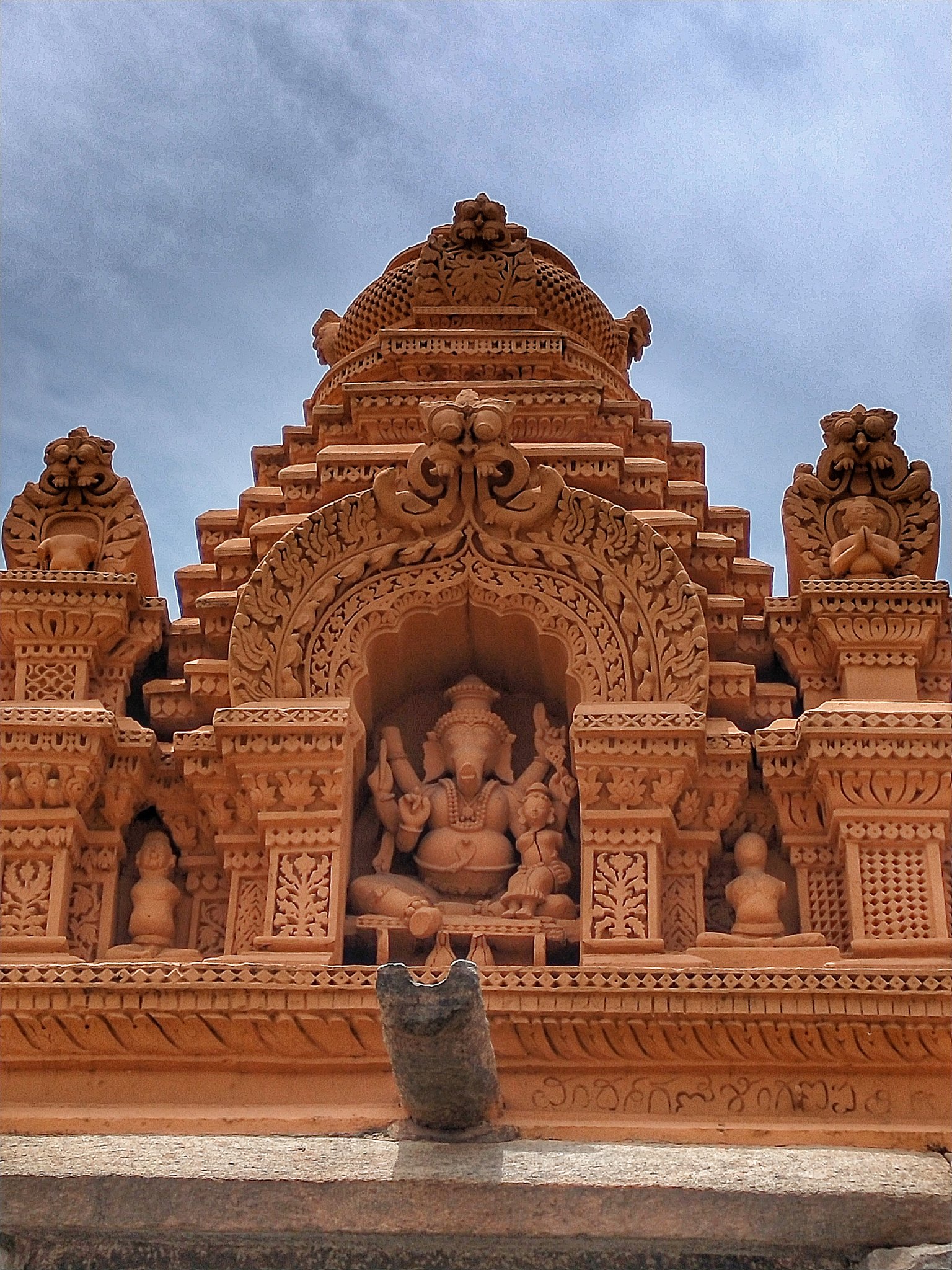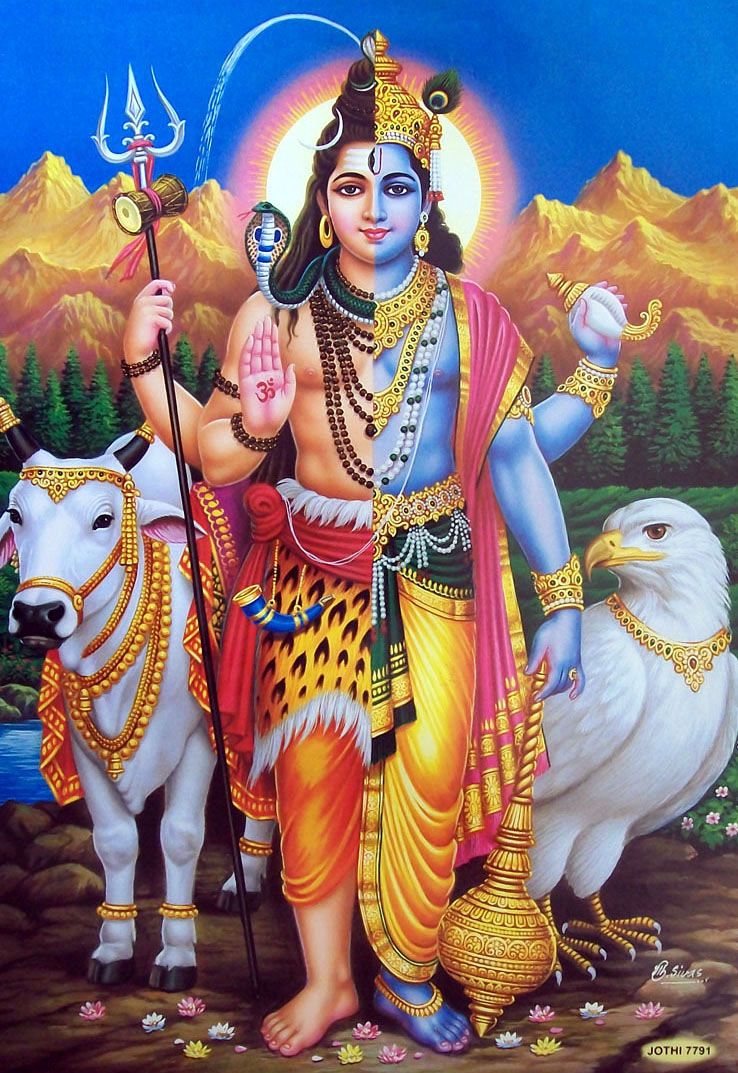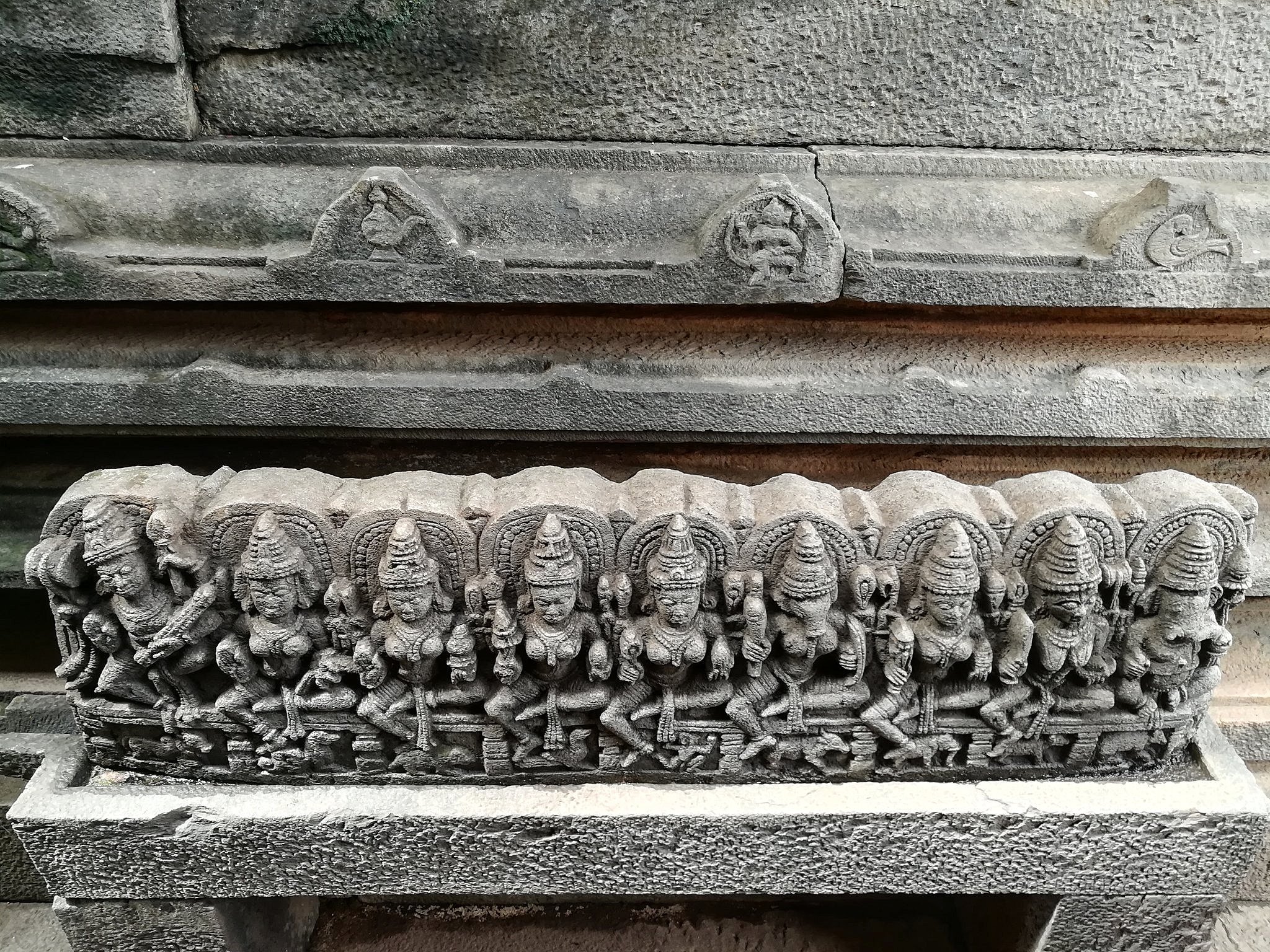On the occasion of Vinayaka Chaturthi, here's my writeup on the many manifestations of Lord Ganesha from the Srikanteshwara Swamy Temple at Nanjangudu near Mysuru in Karnataka. The iconography related to these forms of Lord Ganesha find mention in the Mudgala & Ganesha Purana. The Sritattvanidhi, an iconometric treatise written by the then Maharaja of Mysore, Shri Krishnaraja Wodeyar III also mentions these 32 forms of Vinayaka. In this post we will take a look at each one of these 32 different forms.
The Srikanteshwara Swamy Temple at Nanjangudu is one among the rare temples where each one of these 32 forms of Ganesha have been carved on the outer precincts of the Temple. While some of the forms are well known & widely worshiped, other forms are invoked & worshiped by specific sects only.
 |
| Various forms of Ganesha (from left: Panchamukha Ganapathi, Simha Ganapathi, Heramba Ganapathi and Siddhi Ganapathi) |
Before moving on to the 32 forms, we'll take a brief look at the origins of Ganapathi in our puranas & his subsequent development into a major deity in the pantheon of Hindu gods.
Account from the Linga Purana
The name Vigneshwara first appears in the Lingapurana. Vigneshwara, as the name suggests was the deity conceived in order to put or remove obstacles. Asuras & rakshasas after receiving boons from Lord Shiva, turn out to be a major menace for other Devas. Rendered helpless ,the King of the Devas Lord Indra approaches Lord Shiva with a prayer to create a being who would throw obstacles in the way of the Rakshahas & Asuras in an attempt to render them unfit to receive any further boons. Lord Shiva heeds to this request.
One of the Amshas of Lord Shiva, a part of his power took the form of an brilliant being & was delivered out of the womb of Devi Parvathi. This being was named Vigneshwara by Parameshwara himself. Lord Shiva tasks Vigneshwara to be a major impediment in the path of rakshasas, asuras & other evil beings from attaining boons & other undesirable powers. At the same time Vigneshwara also has the power of removing obstacles in the path of noble & good beings. This is one of the account of the origins of Vigneshwara from the Puranas.
Account from the Shiva Purana
The Shivapurana gives the following account of the birth of Vigneshwara. This is from the Shwetakalpa. Jaya & Vijaya, the companions of Devi Parvathi suggested to her to have a personal Gana(attendant) attending to her exclusively. Parvathi heeds to this advice & creates a being out her own Amsha. Thus was born a handsome young boy. Parvathi orders this boy to keep strict vigil of her quarters with the instruction to not allow anyone inside without her permission. It is during this time that Lord Shiva himself is refused entry by this new Dwarapalaka.
A fight ensues during this time between this valiant boy & Lord Shiva. Angered by this rude behaviour, Lord Shiva instructs his army of Bhuta-Ganas to fight this boy. In the fight that followed the little boy defeats all the Bhuta Ganas single-handedly. Lord Maha Vishnu & Lord Subramanya too try their hand at subduing this boy & they too fail. The stunned Lord Shiva finally manages to subdue him by slicing off the young boy's head.
The news of the killing of this young boy is broke to Parvathi by Sage Narada. Consumed by grief & anger, Parvathi Devi unleashes a host of terrible & terrific goddesses on the Devas who brought grief on her. Narada & other sages pray to Parvathi in order to calm her down & she is assured that her creation will be brought back to life. Lord Shiva then instructs the Devas to head north & bring the head of the first living being they meet & fix it on the neck of the beheaded creation of Devi Parvathi.
The first being the Devas encounter would be an elephant with only a single tusk. Thus sprang to life again Ekadanta(single tusked), who is also known as Gajanana(elephant faced). Ekadanta apologises to his father Lord Shiva & other Devatas for causing them much grief. Lord Shiva in turn appoints his son as the leader of his attendants, the Ganas. Thus Gajanana also came to be known as Ganapathi( Commander of the Ganas)
The Varaha & Matsya Purana too mention in detail the origins of Ganesha, but the above two remain the most popular till this day.
32 different forms of Ganesha
1) Bala Ganapathi
Ganesha in his child form. He has four arms, each holding a fruit; namely mango, jackfruit, banana & sugarcane. He holds the modakam sweet with his trunk. The colour of this form of Ganesha is that of a rising sun.
2) Dhundi Ganapathi
Meaning "the Ganapathi sought after". He has four arms. His right hands holds a tusk & a japamala. The other two arms hold a kuthara(axe) & a ratnapatra(pot of gems)
3) Taruna Ganapathi
Taruna Ganapathi. Represents the youthful form of Ganesha. His arms carry paasa(rope), hook, kadubu(a sweet variety), guava fruit, tusk, paddy & sugarcane. He is red in colour.
4) Nrithya Ganapathi
He is depicted with 4 arms dancing under the sacred Kalpa vriksha(not seen here). He also holds a Trishula with his right upper arm. The colour of the body of this Ganesha has to be golden yellow.
5) Veera Ganapathi
Ganesha has 16 arms here! He wields some of the most fascinating weapons here. That include bhetala, dhanus, bhana, chakra, khagga(sword) , gada, mudgara(hammer), nagapasha, kunta(spear), kutthaara(axe), a dwaja, Alamba(hook),musala(club), trishula, kavacha. Veera Ganapathi is red in colour.
6) Shakti Ganapathi
This manifestation represents the powerful form of Ganesha. He has 6 arms with Shakti devi seated on his left lap. The general characteristics of Shakti Ganapathi are that he should be seated on the padmasana with a green coloured Shakti by his side, whom he should be embracing about her waist, and that there should be no contact between the hips of the god and the goddess. His colour should be that of the setting sun. He should hold the weapons paasa & vajra and be made to look terrific.
7) Dvija Ganapathi
Dvija Ganapathi. Meaning "the Ganapathi twice born" referring to Lord Shiva beheading & restoring him with an elephant's head at the orders of Parvathi devi. Dvija Ganapathi has 4 heads & 4 arms. Totally white in colour. His arms hold a rudraksha, kamandalu, dhanda & pustaka.
8) Vijaya Ganapathi
Victorious Ganapathi. He has 8 arms. According to the Mudgala purana, a purana exclusively dedicated to Ganesha there is also another depiction of Vijaya Ganapathi which is different to this one. Shows him seated on the mookshika & has 4 arms.
9) Rinamochana Ganapathi
Rinamochana Ganapathi. "Ganapathi the liberator from debts" Ganesha is seated on a lotus flower. He is the remover of impediments. He has 4 arms & white in colour. He holds varada mudra, an ankusha, a paasa & a payasapaatra. Invoking this Ganesha will remove all obstacles.
10) Maha Ganapathi
Maha Ganapathi. He is the representation of Ganesha as the supreme parabrahman. Shakti seated on his lap is called Pushti (nourishment).He has 10 arms & red in colour. His hands hold a tusk, pomegranate fruit, musala, sugarcane dhanus, chakra, paasa, kamala, paddy & ratnapatra. Famous Carnatic composer Shri Muthuswami Dikshatar has composed a very famous song on this form of Ganesha called Mahaganapathim manasa smaraami.
11) Shrishti Ganapathi
Ganesha is invoked in this manifestation as the creator of everything that is known. He is red in colour, has 4 arms each holding a tusk, ankusha, paasa & a mango fruit.
12) Heramba Ganapathi
Ganesha, the protector of the weak. He has 5 heads & his vahana is a Simha. He has 10 arms. He holds a Abhaya mudra, a japamala, nimbu fruit, musala, ankusha, paasa, parashu, kadubu sweet, tusk & left arm holds varada mudra which is symbolic of boon giving. The colour of Heramba Ganapathi has to be golden yellow.
13) Kshipra Ganapathi
Kshipra Ganapathi. The Ganesha who is easy to please. He has 6 arms & is red in colour. His hands hold a tusk, a twig of a Kapila vriksha tree, an ankusha & a pomegranate fruit. With the trunk he carries a ratnakumbha.
14) Urddhva Ganapathi

Urddhva Ganapathi. Meaning the "Elevated Ganesha." carries in five of his hands a kalhara flower, ears of paddy, a bow made of sugarcane, the bana & the tusk. With one of his arms he embraces Shakti about her hip. The colour of this Ganapathi is golden yellow and that of the associated Shakti is like that of the lightning. Unfortunately the trunk is broken here & the shakti too is cracked.
15) Simha Ganapathi
Simha Ganapathi. He is lion faced with an elephant trunk. He has 8 arms & is white in colour. With his arms he holds a Veena, a twig of the Kalpa vriksha, a chakra, a kamala, ratnakumbha, Abhaya & varada mudras. This form of Ganesha symbolizes great strength & courage.
16) Durga Ganapathi
Durga Ganapathi. "The invincible Ganesha" having the same attributes of Goddess Durga, who too is invincible. He has 8 arms & is golden in colour. He holds an ankusha, a bhana, a japamala, a paasa, a dhanus, a kalpa vriksha twig, an apple & is dressed in red clothes.
17) Tryakshara Ganapathi
Tryakshara Ganapathi. Known as the Lord of the three most auspicious letters AUM.
He has 6 arms each holding a ankusha, a mango fruit, a tusk, a ghanta. He also holds the modaka sweet with his trunk.
18) Sadashiva Ganapathi
Sadashiva Ganapathi. Ganesha of the highest manifestation. He has 5 faces & 10 arms. Much similar to the Sadashiva iconography of Lord Shiva. His arms hold many weapons similar to Sadashiva & there is also a Shakti seated on Ganesha's lap. This is a very rare depiction.
19) Haridra Ganapathi
Haridra Ganapathi. Turmeric Ganesha. He has 4 arms & is yellow in colour. His hands hold a tusk, an ankusha, the paasa & the modaka sweet.
20) Uddanda Ganapathi
Uddanda Ganapathi. This is the Ganesha who enforces Dharma. He has 10 arms & is accompanied by a Shakti. He is red in colour. His 10 arms each hold a tusk, musala, kamala, paasa, ankusha, paddy, kamandalu, sugarcane dhanus, chakra, shanka & pomegranate fruit.
21) Vighna Ganapathi
Vighna Ganapathi. He has 8 arms & is golden in colour. His hands hold a tusk, a chakra, pushpa bana, shanka, paasa, ankusha, sugarcane, parashu.
22) Vara Ganapathi
Vara Ganapathi. Boon giver Ganesha. He has 4 arms & is red in colour with Shakti seated on his lap.
23) Uchchhishta Ganapathi
Uchchhishta Ganapathi. He has 6 arms & is blue in colour. He holds an akshamaala, a pomegranate fruit, a kamala, a veena, paddy. Shakti is seated on his lap. She is called Vigneshwari.
24) Sankatahara Ganapathi
Sankatahara Ganapathi. The Ganesha who removes sorrow. He has 4 arms & is red in colour. He is dressed in blue & seated on a red lotus flower. He holds a vessel with payasam along with an ankusha & a paasa.
25) Siddhi Ganapathi
Siddhi Ganapathi is depicted in a standing posture. He is the Ganesha who is the epitome of achievement & self mastery. He is golden yellow in colour & has 10 arms using which he holds parashu, ankusha, musala, mudgara, alamba, kuthara, kunta, paasa, sugarcane & mango fruit.
26) Bhakthi Ganapathi
Bhakthi Ganapathi. The Ganesha who is dear to his devotees & is pleasant to look at. He has 4 arms (damaged here.. So is the trunk) He holds a banana, a mango, coconut & a payasapaatra.
27) Kshirpra Prasada Ganapathi
Kshirpra Prasada Ganapathi. The Ganesha who quickly rewards his devotees. He has 8 arms (sometimes 6) and is red in colour. He holds a tusk, an ankusha, lotus flower, Kalpa vriksha leaf, paasa, lemon fruit with his arms.
28) Ekaakshara Ganapathi
Ekaakshara Ganapathi. In this form Ganesha is identified with the Bheejakshara "Gam" He has 4 arms & is red in colour. He holds a single tusk, an ankusha, the paasa & modaka sweet.
29) Ekdanta Ganapathi
Ekdanta Ganapathi. Ganesha with a single tusk. He has 4 arms & is blue in colour. He holds a tusk, a japamala, a kuthara (hatchet) & laddu sweet. The hatchet is held to signify cutting the bonds of ignorance.
30) Yoga Ganapathi
Yoga Ganapathi. Ganesha is in a yogic posture & red in colour. His hands hold a akshamaala & sugarcane. This particular unfortunately is damaged. The trunk too is damaged. Yoga Ganapathi is described as wearing a robe which shines like the blue sapphire gem.
31/32) Panchamukha Ganapathi
Panchamukha Ganapathi. 5 faced Ganesha. While the Mudgala purana mentions a Dvimukha(two faced) & Trimukha(three faced) Ganapathi separately, this Temple at Nanjangudu has a murthi of Panchamukha Ganapathi instead. He is called Kadrimukha Ganapathi. He has 5 faces & 10 arms.
I have also written on 25 different forms of Lord Shiva from the same Temple that can be read
HERE
And also on 10 different forms of Lord Dakshinamurthy from the same Temple that can be read
HERE
References
Elements of Hindu Iconography by TA Gopinath Rao









